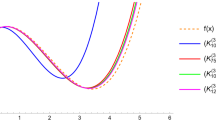Abstract
We establish necessary and sufficient conditions for uniform integrability of the stochastic exponential \({{{\mathcal {E}}}}(M)\), where M is a continuous local martingale.
Similar content being viewed by others
References
Chikvinidze, B.: An extension of the mixed Novikov–Kazamaki condition. Infin. Dimens. Anal. Quantum Probab. Relat. Top. 20(04), 1750022 (2017)
Chikvinidze, B.: A new sufficient condition for uniform integrability of stochastic exponentials. Stoch. Int. J. Probab. Stoch. Processes 89(3–4), 619–627 (2017)
Gihman, I.I., Skorohod, A.V.: Stochastic Differential Equations. Springer, Berlin (1972)
Girsanov, I.V.: On transforming a certain class of stochastic processes by absolutely continuous substitution of measures. Theor. Probab. Appl. 5, 285–301 (1960)
Kazamaki, N.: A sufficient condition for the uniform integrability of exponential martingales. Math Rep. Toyama Univ. 2, 1–11 (1979)
Kazamaki, N.: Continuous Exponential Martingales and BMO. Lecture Notes in Mathematics, vol. 1579. Springer, Berlin (1994)
Liptser, R.Sh, Shiryaev, A.V.: On absolute continuity of measures associated with processes of diffusion type with respect to the Wiener measure. Izv. A. N. USSR Ser. Math. 36, 847–889 (1972). (in Russian)
Novikov, A.A.: On an identity for stochastic integrals. Theor. Prob. Appl. 17, 717–720 (1972)
Ruf, J.: A new proof for the conditions of Novikov and Kazamaki. Stoch. Process. Appl. 123, 404–421 (2013)
Acknowledgements
I am very grateful to unknown referees for very helpful and important comments.
Author information
Authors and Affiliations
Corresponding author
Additional information
Publisher's Note
Springer Nature remains neutral with regard to jurisdictional claims in published maps and institutional affiliations.
Appendix
Appendix
Here we introduce four important lemmas with proofs. These lemmas are essential in the proof of Theorems 1 and 2.
Lemma 1
Let \(f:[0;+\infty ) \rightarrow (0; +\infty )\) be a non-decreasing function with \(\lim _{x\rightarrow \infty }f(x) = \infty \). Then, a non-decreasing, absolutely continuous function \(g:[0;+\infty ) \rightarrow [0; +\infty )\) exists which satisfies the following conditions:
-
(a)
\(g(x)\le f(x)\);
-
(b)
\(\lim _{x\rightarrow \infty }g(x) = \infty \);
-
(c)
\(g(x+y)\le g(x)+y+2\).
Proof
Define the function F: \(F(x) = \sum ^{\infty }_{k=1}f(k-1)1_{[k-1; k[}(x)\). It is obvious that \(F(x)\le f(x)\). Let us denote by \(\bigtriangleup F(k)=F(k)-F(k-1)\) the jumps of F. Because f is non-decreasing, the jumps of F will be nonnegative. Now define a non-decreasing sequence \((g_k)_{k\ge 1}\) through the recurrence relationship:
As a result, we have points \((k; g_k), \,\,\, k\ge 0\). Define function g by connecting points \((k; g_k)\) with straight lines. It follows from the definition that g is absolutely continuous, non-decreasing, \(g(x)\le F(x) \le f(x)\) and \(\lim _{x\rightarrow \infty }g(x) = \infty \). It remains to show that \(g(x+y)\le g(x)+y+2\). Let us take \(x\in [k-1;k[\) and \(y\in [n-1;n[\). It is clear that \(x+y \le k+n\). Using the definition of the function g, we obtain:
So, by arbitrariness of k and n, \(g(x+y)\le g(x)+y+2\). \(\square \)
Lemma 2
For any random variable \(\xi \) such that \(P(0\le \xi < \infty )=1\) there exists a positive, non-decreasing and continuous function g with \(\lim _{x\rightarrow \infty }g(x) = \infty \), such that \(Eg(\xi ) < \infty \).
Proof
If \(\xi \) is a bounded random variable, then the proof of Lemma 2 is trivial, so we can consider only the case when \(\xi \) is unbounded. In this case, \(F_{\xi }(x)<1\) for any \(x\in [0;+\infty )\) where \(F_{\xi }(x) = P(\xi \le x)\) is the probability distribution function of \(\xi \). Let us take \(f(x)=\frac{1}{\sqrt{1 - F_{\xi }(x-)}}\). Then we will have:
Here we have used the inequality \(-2\sqrt{1-F_{\xi }(x)} + 2\sqrt{1-F_{\xi }(x-)}-\frac{\Delta F_{\xi }(x)}{\sqrt{1-F_{\xi }(x-)}} \ge 0\), which follows from the convexity of the function \(y \rightarrow -2\sqrt{1-y}\). Now if we use Lemma 1, we can find an absolutely continuous, positive and non-decreasing function g with \(\lim _{x\rightarrow \infty }g(x) = \infty \), such that \(g(x)\le f(x)\). The inequalities \(g(x)\le f(x)\) and \(Ef(\xi ) < \infty \) imply that \(Eg(\xi ) < \infty \). \(\square \)
Lemma 3
Let \(\varphi \) be a lower function. Then, the function \(\psi (x)=\varepsilon \varphi (\frac{x}{\varepsilon ^2})\) will be a lower function, too.
Proof
It is well known that if \(B_t\) is a Brownian motion, then \(W_t = \varepsilon B_{t/\varepsilon ^2}\) will be Brownian motion, too. With this if we take \(s=t/\varepsilon ^2\), then we will have:
\(\square \)
Lemma 4
For any \(\varepsilon >0\), there exists \(\delta > 0\) sufficiently close to 0 such that the inequality \(\delta x^2 + \delta \varepsilon \le \frac{1}{2}(x-1)^2\) holds true for any \(x \notin (1-\varepsilon ; 1+\varepsilon )\).
Proof
It is clear that we can take \(\delta >0\) sufficiently close to 0 such that
It is easy to check that for such \(\delta \) the condition \(|x-1|\ge \varepsilon \) implies the inequality
which is equivalent to \(\delta x^2 + \delta \varepsilon \le \frac{1}{2}(x-1)^2\). \(\square \)
Rights and permissions
About this article
Cite this article
Chikvinidze, B. Necessary and Sufficient Conditions for the Uniform Integrability of the Stochastic Exponential. J Theor Probab 35, 282–294 (2022). https://doi.org/10.1007/s10959-020-01047-4
Received:
Revised:
Published:
Issue Date:
DOI: https://doi.org/10.1007/s10959-020-01047-4




